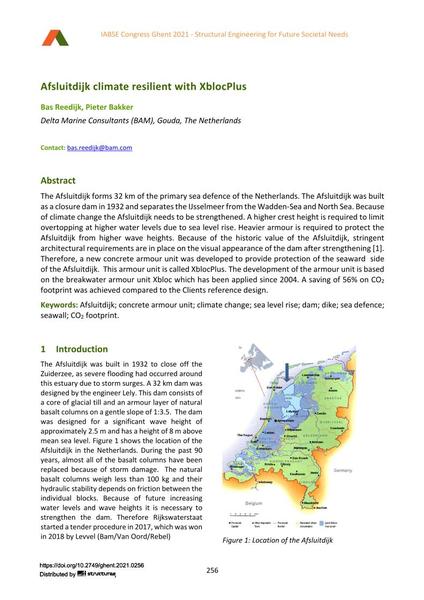Afsluitdijk climate resilient with XblocPlus

|
|
|||||||||||
Bibliographic Details
| Author(s): |
Bas Reedijk
(Delta Marine Consultants (BAM), Gouda, The Netherlands)
Pieter Bakker (Delta Marine Consultants (BAM), Gouda, The Netherlands) |
||||
|---|---|---|---|---|---|
| Medium: | conference paper | ||||
| Language(s): | English | ||||
| Conference: | IABSE Congress: Structural Engineering for Future Societal Needs, Ghent, Belgium, 22-24 September 2021 | ||||
| Published in: | IABSE Congress Ghent 2021 | ||||
|
|||||
| Page(s): | 256-264 | ||||
| Total no. of pages: | 9 | ||||
| DOI: | 10.2749/ghent.2021.0256 | ||||
| Abstract: |
The Afsluitdijk forms 32 km of the primary sea defence of the Netherlands. The Afsluitdijk was built as a closure dam in 1932 and separates the IJsselmeer from the Wadden-Sea and North Sea. Because of climate change the Afsluitdijk needs to be strengthened. A higher crest height is required to limit overtopping at higher water levels due to sea level rise. Heavier armour is required to protect the Afsluitdijk from higher wave heights. Because of the historic value of the Afsluitdijk, stringent architectural requirements are in place on the visual appearance of the dam after strengthening [1]. Therefore, a new concrete armour unit was developed to provide protection of the seaward side of the Afsluitdijk. This armour unit is called XblocPlus. The development of the armour unit is based on the breakwater armour unit Xbloc which has been applied since 2004. A saving of 56% on CO₂ footprint was achieved compared to the Clients reference design. |
||||
| Keywords: |
climate change dam dike Sea level rise Afsluitdijk concrete armour unit sea defence seawall CO2 footprint
|
||||
| Copyright: | © 2021 International Association for Bridge and Structural Engineering (IABSE) | ||||
| License: | This creative work is copyrighted material and may not be used without explicit approval by the author and/or copyright owner. |
||||
